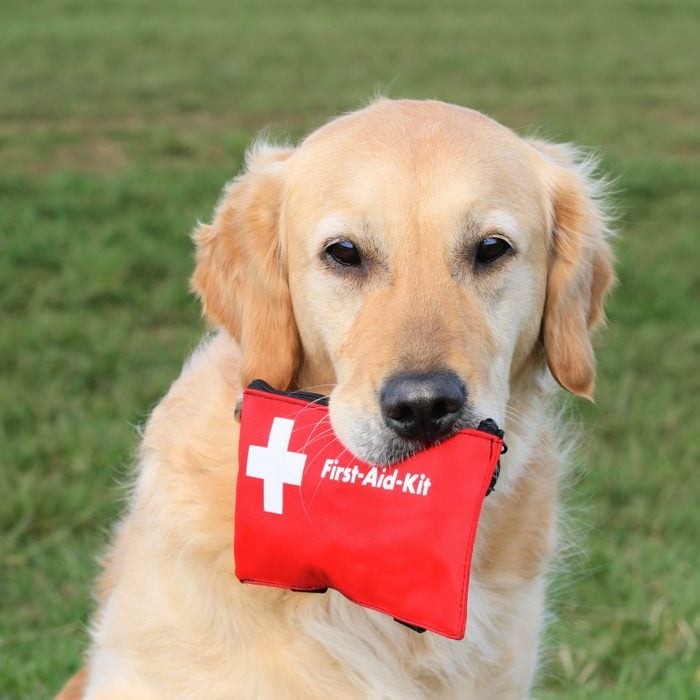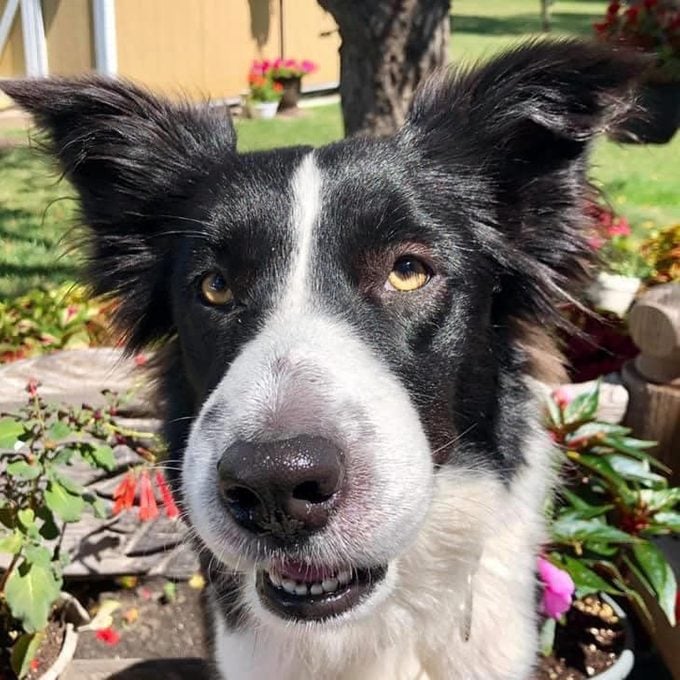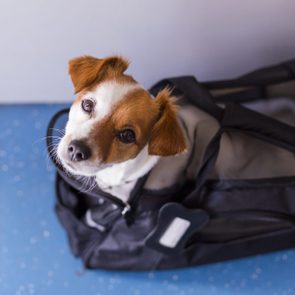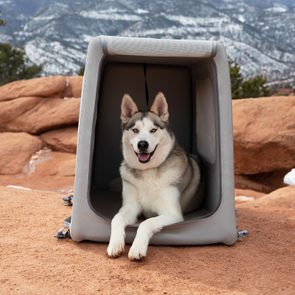Having This One Thing in My Pet First Aid Kit Saved My Pet’s Life
Updated: Jun. 23, 2023

A terrifying wasp attack proves the importance of having a pet first aid kit
I love hiking with my pups. It’s a win-win for all of us: I need exercise. Dogs need exercise. And all of us need to spend a little time in the great outdoors. I have two Rotties, Cora and Mabel, and we’ll hike three to five miles a day near our home in western New York. It’s beautiful here, up near the Canadian border and Niagara Falls—but it’s also really rural. And in the wilderness, you always have to be prepared. Hence the pet first aid kit I tote with me.
Depending on where you live and whether you’re taking your four-legged friends for a quick trip to the dog park, a long hike in a pet-friendly national park, an overnight camping trip or anything in between, you might want to keep different things in a pet first aid kit. But there’s one thing I never go out without. And one afternoon in August 2020, it made the difference between life and death.
Get Reader’s Digest’s Read Up newsletter for more pet tips, humor, cleaning, travel, tech and fun facts all week long.
Drama on the trail

My friend Denise and I had decided to take our dogs to some open fields near our property. I brought Cora and Mabel, and Denise had her six border collies, including her senior dog, Zeke. We’d been to the area just the day before, and the dogs had had a great time running and playing. This trip started out the same: a bunch of happy dogs having a blast. But things took a sudden turn for the scary.
The dogs started running and yelping, and we saw a swarm of yellow jackets. They were just everywhere. Cora and Zeke had been in the front, and they must have stepped into a ground nest. We started frantically running and calling for the dogs, but they were preoccupied. They were getting stung, and so were we.
We ran. And we kept running (and running) until the yellow jackets gave up the chase.
Once we reached a safe spot free of yellow jackets, we stopped to see how everyone was doing. We’d all been stung a couple of times, but Cora and Zeke had taken the worst of it. Cora was absolutely covered in stings—her underside, the sides of her face, her ears. There were 12 stings that we could see, maybe more that we couldn’t. I didn’t know if she was allergic, but she was clearly miserable.
Zeke, on the other hand, was allergic, and his face had already started to swell. As with humans, stings can be really serious for dogs that are allergic. They can cause the throat to swell and make it hard to breathe. But here’s the scariest part: You never know if a dog is allergic until the first sting.
Help at hand
Years ago, I had seen another dog collapse after being stung by ground bees. The owner happened to be a veterinarian, and I’d watched her pull a bottle of liquid Benadryl—a fast-acting antihistamine—out of her bag and use a syringe to squirt it into the dog’s mouth. That’s when I started carrying the medication in my hiking pack.
So when faced with two sting-spotted dogs, I knew what to do. I pulled out my bottle of children’s Benadryl and gave some to both Cora and Zeke. It started working right away. I gave Cora another dose when we got home, and by the next day, it was like the yellow-jacket attack had never happened. Both she and Zeke were fine.

Of course, it’s important to talk to your vet to figure out the right amount of Benadryl to give, depending on the size of your dog, and to make sure your pup doesn’t have any other health issues that could make the medication dangerous. You also need to make sure you’re giving your furry friend plain Benadryl or its generic form, diphenhydramine. Stay away from the versions with added acetaminophen and decongestants, as well as the sugar-free kind that uses xylitol. All of those things can be toxic to pets.
I like liquid Benadryl, but you can also use Benadryl tablets. They just take a little longer to work. Whichever you choose, be sure your pet first aid kit has a fresh supply that isn’t past its expiration date.
When I’m hiking with my dogs, I’m as likely to have Benadryl on me as I am to have poo bags. It takes up a good amount of space in my little fanny pack kit, but it’s worth it.
How to make a pet first aid kit
A pet first aid kit isn’t meant to replace veterinary care, but it might be able to keep your pet alive until you can get to the vet. And while you can often use a human first aid kit in a pinch, experts recommend you stock a pet first aid kit as part of your home emergency gear.
“We definitely recommend that every owner has a first aid kit and supplies that they would have quick access to in an emergency,” says Deborah C. Mandell, VMD, a professor of emergency and critical care medicine at Ryan Veterinary Hospital of the University of Pennsylvania and a pet-care advisor to the American Red Cross.
Most prepackaged pet first aid kits are for both cats and dogs, so it’s important to check the contents to make sure the items are the appropriate size for your pet and that it contains everything you need. “You should also always ask your veterinarian for specific items your pet may need, depending on any underlying health issues,” says Dr. Mandell.
If you decide to make your own pet first aid kit, she suggests the following must-haves:
- Sterile gauze pads, gauze sponges and roll gauze for bleeding emergencies
- Roll of cohesive wrap (sometimes called VetWrap)
- Adhesive tape
- Antiseptic wipes
- A muzzle (even the friendliest pet may lash out when in pain)
- Thermometer
- Disposable nonlatex gloves
- Blunt-end scissors
- Nail clippers
- Grooming clippers
- Sterile saline eyewash
- Kwik Stop Styptic Powder to stop bleeding from broken nails
- Tweezers to remove ticks
- Your pet’s vaccination records and information about any underlying health issues, including allergies
- Important phone numbers (such as animal poison control, your veterinarian, the nearest emergency animal hospital)
The free American Red Cross Pet First Aid app has instructions on when and how to use those items, as well as information about the ABCs of dog and cat first aid. The organization also offers pet CPR courses online.
A cautionary note about Benadryl
Some pet owners also like to include the antihistamine diphenhydramine (aka Benadryl) in their pet first aid kit in case of stings and allergic reactions. I’m one of them, and boy did it serve me well. But if you’re going to do the same, be smart about it. Using the wrong version of the medication is a major mistake pet owners can make.
Diligent pet parents will talk to a veterinarian about the dosage and any contraindications. “Their veterinarian will tell them the dose and how and when they can give it,” says Dr. Mandell. “It is imperative to make sure it is only diphenhydramine—no fever reducer, anti-inflammatory, pain medications or cold medications.” Benadryl that contains Tylenol, ibuprofen, phenylephrine or other drugs aside from diphenhydramine should never end up in your pet first aid kit.
Tips for your pet first aid kit
At home, store your pet first aid kit within easy reach, like the spot where you keep the dog leash and carrier. That way, you won’t forget it before you head out on an adventure with your favorite fur ball.
Prepping the kit is also a good way to prepare for a tornado, wildfire, hurricane or other natural disaster. Should you and your pet need to evacuate, it’ll be easy to grab and go.
Pet owners who like to road trip with their dogs may want to put together a compact version of the pet first aid kit to take on vacation, while adventure-seekers who like to hike and camp with their pets might consider adding a rescue harness to their kit. If your 80-pound dog has a medical emergency when you are a mile away from the trailhead, it can allow you to safely carry him back to get help.
However you build your pet first aid kit, make sure to always replace the materials inside as you use them so you’ll have it ready for the next time. And while your kit will never replace professional veterinary care, it can give you peace of mind knowing you’re prepared in the event of a pet emergency.
Source:
- Deborah C. Mandell, VMD, American Red Cross pet care advisor and professor of emergency and critical care medicine at Ryan Veterinary Hospital of the University of Pennsylvania


